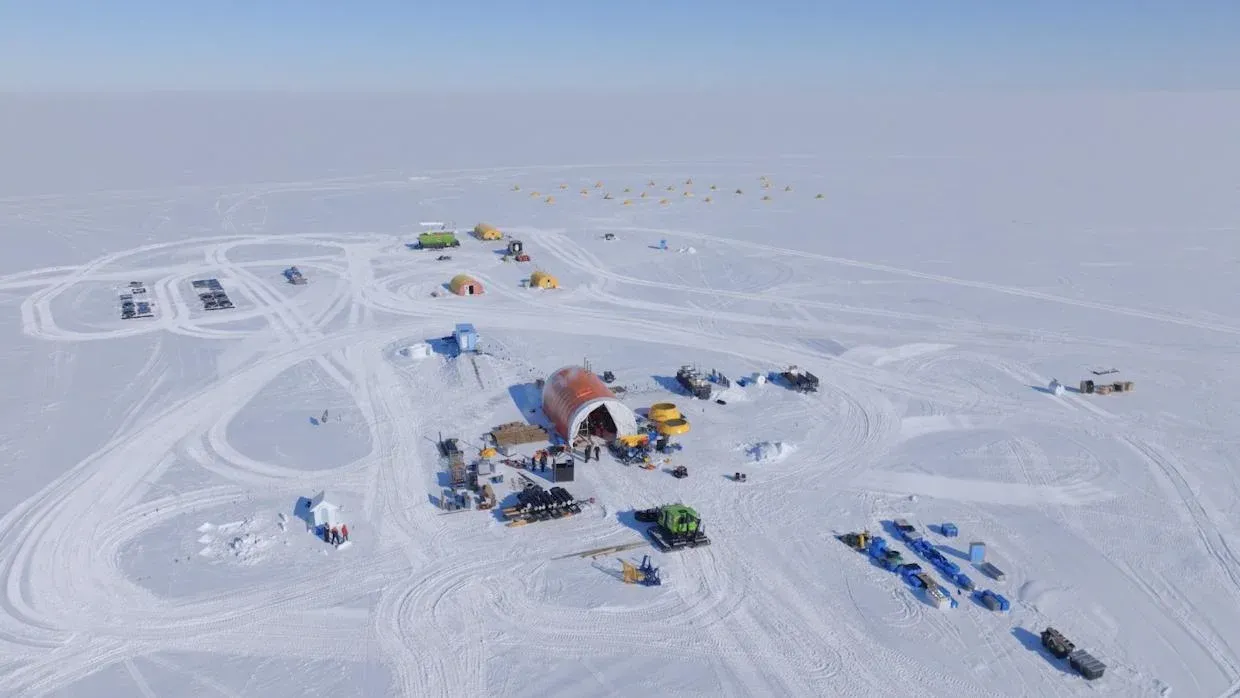International team embarks on 1128km journey to recover critical geological records in Antarctica.
A global team of researchers, scientists, and Antarctic field specialists from 13 countries has embarked on a mission to recover “critical to humanity” geological records from the West Antarctic Ice Sheet. The team’s objective is to help forecast future sea-level rise by understanding the collapse of this ice sheet, which holds enough ice to raise sea levels by 4 to 5 meters if melted completely.
The team has set up camp on the edge of the West Antarctic Ice Sheet, where they will attempt to drill a hole through around 580m of the ice shelf. The drilling process is expected to reveal information contained in sediment layered in the sea floor under the Ross Ice Shelf. The team aims to retrieve a sediment core from up to 200m deep into the seabed, which will provide valuable insights into how the West Antarctic Ice Sheet will respond to future warming.
The importance of this mission cannot be overstated. According to Prof Richard Levy, SWAIS2C Co-chief Scientist, “Understanding what temperature will trigger unavoidable melt of the Ross Ice Shelf, and the subsequent collapse of the West Antarctic Ice Sheet, is critical for all of humanity.”
The team’s efforts are part of the Sensitivity of the West Antarctic Ice Sheet to 2°C project. The project aims to investigate how the West Antarctic Ice Sheet will respond to a 2°C increase in global temperatures, which is projected to occur within the next few decades.
The drilling process is expected to be challenging, with technical difficulties scuppering their efforts last year. However, the team is determined to complete the mission and retrieve the coveted core. The core is expected to reach back hundreds of thousands of years, potentially millions of years, and will provide valuable insights into how the West Antarctic Ice Sheet behaved during past warmer periods.
The sequence of rocks and mud in the core will reveal how the West Antarctic Ice Sheet responded to future warming. If the researchers find marine algae, indicating open ocean conditions, it is likely that the ice sheet retreated. The team hopes that the results will guide plans to adapt to unavoidable sea-level rise and amplify the imperative to mitigate global greenhouse gas emissions.
The SWAIS2C project has been hailed as “the discovery for our lifetime” by the team. Prof Tina van de Flierdt, SWAIS2C Co-chief Scientist, from Imperial College London, said, “Retrieving this sample from such a remote location will help us build a clearer picture of how the West Antarctic Ice Sheet will respond to future warming, which parts will melt first and which parts will remain. We’re using the past to help us prepare for our future.”
Logistical Challenges
Drilling at a deep-field station in Antarctica is a significant logistical challenge. The team had to travel 1128km over the Ross Ice Shelf, which took around 15 days. They used Ground Penetrating Radar to detect and avoid treacherous crevasses, and created a runway on the ice for ski-equipped aircraft.
The journey was made possible by the support of Antarctica New Zealand, which provided funding and resources for the project. The organization’s Acting Chief Executive, Prof Jordy Hendrikx, said that quantifying Antarctica’s contribution to sea-level rise is a strategic priority for New Zealand. “This project underscores the importance of international collaboration in addressing the critical questions surrounding our planet’s future,” he said.
The team’s efforts are also supported by the Basler aircraft, which transported them to the KIS-3 camp. The aircraft played a crucial role in delivering the equipment and provisions needed for the mission.
What’s at Stake
The fate of the West Antarctic Ice Sheet and its contribution to sea-level rise is a critical issue that requires immediate attention. If the ice sheet collapses, it could raise global sea levels by several meters, threatening coastal communities and ecosystems around the world.
The team’s efforts aim to provide valuable insights into how the West Antarctic Ice Sheet will respond to future warming. By understanding the collapse of this ice sheet, we can better prepare for the impacts of sea-level rise and take action to mitigate its effects.
Conclusion
The international team’s mission to recover critical geological records from the West Antarctic Ice Sheet is a crucial step in understanding the impact of climate change on our planet. The team’s efforts aim to provide valuable insights into how the ice sheet will respond to future warming, which will help us better prepare for the impacts of sea-level rise.
The success of this mission depends on the international collaboration and support that has been provided by organizations like Antarctica New Zealand. As we face the challenges of climate change, it is essential that we work together to address these critical questions and ensure a sustainable future for our planet.
The SWAIS2C project is a testament to human ingenuity and determination in the face of adversity. By working together, we can uncover the secrets of Antarctica’s ice sheet and take action to mitigate its impact on our planet.
The future of our planet depends on our ability to understand and address the challenges posed by climate change. The international team’s mission is a crucial step towards this goal, and we must support their efforts with every means at our disposal.
We can only hope that the results of this mission will be used to inform policies and actions that will help us mitigate the impacts of sea-level rise and ensure a sustainable future for generations to come.

0 Comments